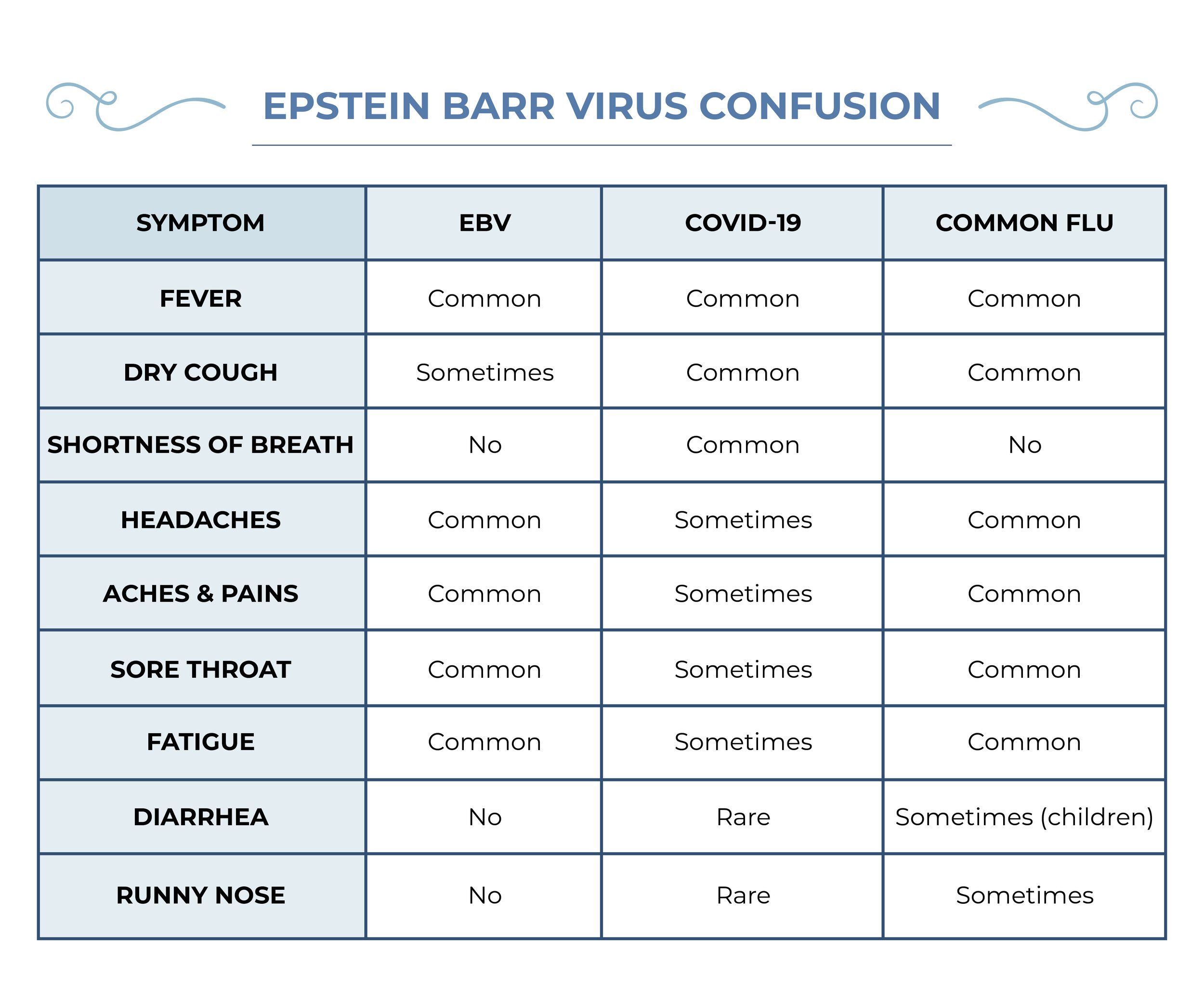Chronic Epstein-Barr Virus (EBV) Testing
When Does a Common Infection Become a Chronic Problem?
Watch my recent video on lab testing options, plus how they relate to coronavirus, here.
Approximately 90% of people in the world become infected with the Epstein-Barr virus. Often times it's nothing more than a few weeks of fever, body aches, and feeling downright lousy. In a small percentage of people, these symptoms don’t go away. In fact, a chronic Epstein-Barr virus infection can even trigger other health problems at the genetic level!
Keep reading to learn about the difficulties of diagnosing EBV infection, the Epstein-Barr virus test, and a simple way to give your immune system a fighting chance.
Epstein-Barr Virus Confusion
You’re more familiar with Epstein-Barr virus than you may realize. EBV, aka human herpesvirus 4, is responsible for causing more than 90% of infectious mononucleosis. (1) More often called mono or “the kissing disease,” symptoms are quite mild. Below is a comparison of symptoms associated with EBV, COVID-19, and the common flu. (2)
Other EBV infection symptoms include:
Swollen lymph nodes
Enlarged spleen
Swollen liver
Rash
As you can see from the list of symptoms above, it is difficult to diagnose EBV, coronavirus, or the common flu on symptoms alone. (For more about the coronavirus check out our blog here.)
There are no current therapies to address acute EBV infections. The CDC recommends to stick to the basics such as stay hydrated, get rest, and use OTCs like aspirin and acetaminophen for fever. (2)
Chronic EBV Puts You at Risk
EBV infections typically run their course in 2-4 weeks. But there is a subset of people who cannot shake this nuisance of a virus. Epstein-Barr causes several complications in these patients.
Occasionally EBV can evade our immune defenses and cause serious issues. Since there are no current medications or therapies for EBV, if our body’s immune army isn’t victorious, we are open to attacks from other infections.
“Chronic active Epstein–Barr virus disease is usually defined as a chronic illness lasting at least 6 months, an increased EBV level in either the tissue or the blood, and lack of evidence of a known underlying immunodeficiency” (3)
Symptoms of EBV may come and go or last until the infection has been properly addressed.
EBV works, like most viruses, by downregulating our immune system. It does this by blocking signals that initiate immune cells like NK-cells, T-cells, and B-cells. (3)
When these cells are downregulated or impaired, we become susceptible to more opportunistic infections like the flu and coronavirus. Along with this, evidence has shown that people with chronic EBV infections are at a greater risk of autoimmune conditions. Researchers think EBV may contribute to the following: (4)
Multiple Sclerosis
Rheumatoid Arthritis
Inflammatory Bowel Disease
Type I Diabetes
Juvenile Idiopathic Arthritis
Celiac
The researchers conclude EBV causes autoimmunity and other immune issues by changing the expression of our DNA! (4)
Testing for EBV
How to test EBV may appear confusing. Many physicians won’t test adults for EBV because they don’t see the value and are running the wrong test.
Looking at IgG and IgM levels can tell us whether this is a new or old infection. There are 4 different biomarkers we look at when determining if you have an EBV infection.
Traditionally most doctors will look at 3 biomarkers that can miss some people. To really get a full picture, your EBV test should look at all 4 of these biomarkers together. Below is an explanation of each EBV antibody test.
1. EBV Viral Capsid Antigen (VCA) IgM
EBV has a capsid which is essentially the outer protective barrier of the virus. IgM is our immune system’s first attempt to get rid of an infection. A positive EBV-VCA IgM tells us that you currently have EBV infection or it has been reactivated. (5)
2. EBV VCA IgG
This is similar to the above; however, IgG tells a slightly different story. IgG is primarily produced after we have been exposed to the virus and the immune system has had time to study it. Each type of IgG molecule is a finely tuned antibody that is unique to a specific invader the immune system is looking to eliminate. When the test is positive for EBV VCA IgG, it lets us know you’ve had or currently have an EBV infection. (5)
3. EBV Nuclear Antigen (NA) IgG
The EBV NA IgG detects the presence of proteins found in the virus nuclei. Since most people (90%) have encountered EBV when they were kids, this is most often positive. However, if other markers are positive and this is negative, it indicates you may have a weak immune response. (5)
4. EBV Early Antigen (EA) D IgG
This biomarker really allows us to put everything together. Without measuring EBV EA-D IgG, many people suffering from an EBV infection get lost through the cracks. The EBV EA-D IgG tells us if the virus is in the process of replicating. (5)
All 4 of these biomarkers must be used together in order to determine your current status with EBV. One biomarker is not enough to accurately diagnose you with EBV. For example, most people will have VCA IgG and NA IgG present because of the prevalence of EBV infections in childhood. But, their absence when EA-D IgG is present can tell us there is an immune deficiency.
Is It Time to Test for EBV?
I have chronic Epstein Barr virus myself, but before I was practicing functional health coaching myself it was hit or miss to find practitioners who could help me. EBV testing is tricky to interpret and conventional practitioners don’t even believe in chronic EBV.
That’s why I am so excited to now offer Epstein-Barr testing with interpretation and support!
Reasons to test include:
Chronic fatigue syndrome
Chronic swollen lymph nodes/sore throat
To differentiate from other viruses
To know if you are being immuno-compromised by EBV
To learn if you have chronic EBV so you can address it and manage it.
Chronic EBV Panel
This test includes:
EBV Viral Capsid Antigen (VCA) IgM
EBV VCA IgG
EBV Nuclear Antigen (NA) IgG
EBV Early Antigen (EA) D IgG
Optional private consultation
Ready to test? Emails us at help@bridgitdanner.com
Supplements to the Rescue…
Here are some supplements I use for EBV. Note that they go hand-in-hand with coronavirus protection!
Vitamin D
By now, there isn’t much I can tell you about the importance of vitamin D. This crucial vitamin coordinates much of our immune system. When our vitamin D is low, we are at a greater risk of infection. Additionally, people with EBV and low vitamin D are at alarmingly high risk for multiple sclerosis. (8)
Olive Leaf Extract
Olive Leaf Extract may be effective at treating viruses like Epstein-Barr. (9) One of the compounds found in olive leaf called oleuropein has tremendous health benefits that extend beyond just EBV including: (10)
Potent antioxidant
Powerful anti-inflammatory
Anti-atherogenic
Anti-cancer
Antimicrobial
And of course… antiviral
Having EBV can be challenging. During this time of year, it can be even worse. Fortunately, Olive Leaf Extract helps me manage my EBV. I recommend olive leaf only if you have a current, active viral infection. To read more about the benefits of olive leaf extract check out this blog.
SCIENCE-BACKED SUPPLEMENTS FOR SAFE IMMUNE SUPPORT
Are you wondering how to best support your immunity? Theories abound, but not all of them are based on facts. In this book, I only present the information I can back up. I’ll do some myth-busting and share some information on dealing with pre-existing conditions and keeping your immunity strong!
Get 10% off your first order when you grab my guide and arm yourself with the healthy facts!
Do you struggle with EBV symptoms? What have you learned? Share with us in the comments below!
Bridgit Danner, LAc, FDNP, is trained in functional health coaching and has worked with thousands of women over her career since 2004. She is the founder of Women’s Wellness Collaborative llc and FunctionalDetoxProducts.com.
Check our her easy 5-Day DIY Detox Guide here!














Silver has been valued for centuries for its natural antimicrobial properties. When silver particles come into contact with bacteria, fungi, or viruses, they disrupt the microbe’s cell membranes and interfere with their ability to survive and reproduce. This makes silver an effective tool for reducing harmful microorganisms on surfaces, in water, and even in the body (when used appropriately).